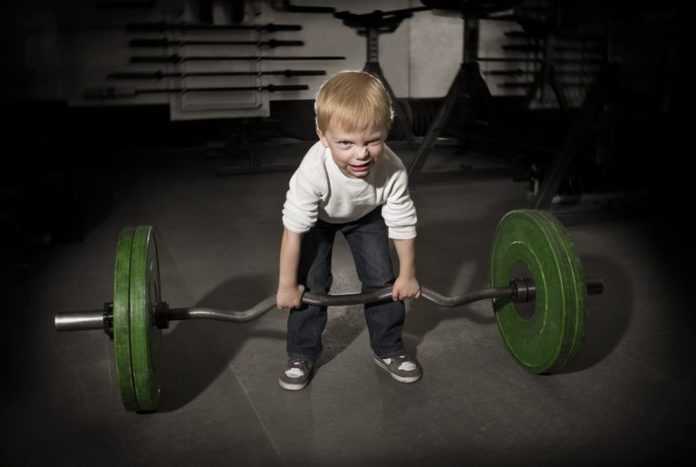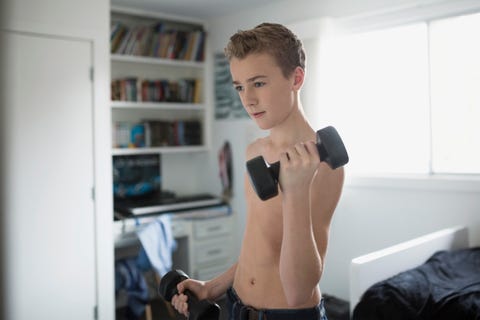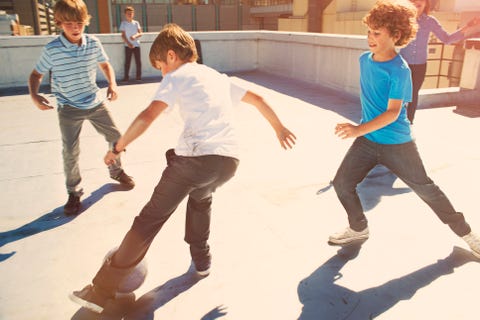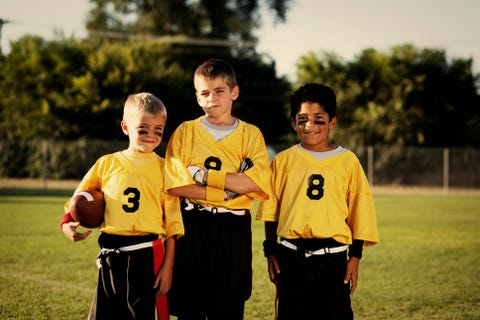You might be concerned about stunted growth — but there’s more to youth strength training than that.
Countless people have experienced the benefits that come with strength training as adults as a way to break from their sedentary routines to get fit — but for many, the introduction to weight lifting and conditioning came in their teenage years as a way to train for sports.
Most high school athletic programs have some sort of strength training component, but club and travel sports have ramped up the stakes in kids athletics at an even earlier stage. Parents and concerned coaches aren’t wrong, then, to question what age is actually safe for kids to hit the weights. Is it only after the onset of puberty? Or will a strength program stunt growth, like some old wives tales would have you believe?
To answer these questions, it might be better to understand the reasons why an adolescent strength training plan would even be necessary.
Let The Kids Grow
Kids used to be able to get in shape by playing on their own terms and by their own rules. They could develop an interest in organized or recreational sports, or they might just have been interested in having fun. Fun is described as the balance between success and challenge, being with peers, and learning new things, and unsurprisingly, it’s the number one reason children play sports.
Many adults, however, have been sold the notion that the only way to sporting success is to earn an athletic scholarship. The only way to find success in that mode of thinking is to have their aspiring professional athlete specialize in one sport, attend as many elite performance camps as possible, and completely pack out a youth athlete’s calendar, with little room for anything but that one sport. Counterintuitively, this has led to reduced levels of strength and fitness, lack of motor skill development and sports skills, and declining interest in sports and fitness among children.
LTAD helps adults fix five fallacies in youth physical development:
- 1. Strength training will stunt growth
- 2. Good performance early in sports and resistance training tells us who has athletic talent
- 3. Use the programs the pros use
- 4. To be successful in sport, kids should specialize early
- 5. Just moving is enough
Strength training is key to motor skill development and athleticism. Contrary to what you might have heard, introducing a strength protocol to young athletes will not stunt their growth. This doesn’t mean that kids should be lifting heavy weights on principle, however — but they should be getting familiar with different types of resistance, like bodyweight (pushups, planks, and changing direction), free weights, bands and tubes, and other implements.
Kids can begin resistance training around the same age they become interested in sports — usually between 6- and 8-years-old. Moving with proper form requires adequate muscular strength, after all, so resistance training of some kind should be a prerequisite for sports participation. The expression “Get in shape to play, not play to get in shape” holds true.
All that said, you should be cautious of programs that prescribe being able to do bodyweight exercises before exercise with weights. Children who are overweight or obese need to exercise and should experience the success of lifting an external weight rather than trying to move their bodyweight. The key is to find the exercise, sport, or activity your child enjoys and build on the success of that.
Just because a child is stronger than his or her peers or is better at a sport (or several sports) does not mean that this child is the next prodigy. Many youngsters change their interest and need to try several types of activities, exercises, and sports. Those kids that outperform their young peers may have physically developed early and need to be watched to be sure they are not overworked and overplayed. Those that are late bloomers (this can be measured by a process called peak height velocity that factors parents’ heights and the child’s height and age) need extra attention to be sure they get adequate time to participate.
Giving kids the opportunity to try different sports as they grow up gives them the opportunity to pursue the one they like best, should they choose one at all. They will develop a wide variety of movement skills and abilities, which can then transfer to enjoying pursuit of being physically active throughout their lives, a concept known as physical literacy.
Being physically literate means that kids (and adults) can move confidently and competently in a variety of settings, whether that be on a field, track, ice rink, or in the water. The concept shouldn’t be shoved onto kids (or adults, for that matter) in a one-size-fits-all model, either — we don’t expect all kids to ace Advanced Placement Math, for example.
Fitness programs, like sports training protocols, need to be individualized, which means they should be adjusted to fit each person. The program should be based on a child’s level of development and level of interest. In that sense, using a college program for high school athletes is inappropriate. We can understand the type of work that can be done in the weight room based on the level of experience of the lifter.
Think about it like this: We would never allow kids to drive without learning the technique, rules, and the progressions of safety, yet too often we see youth athletes undertaking exercise programs for which they are not ready.
This is especially true for the “run them ‘til they puke” mindset. Anybody can make a kid tired, but that doesn’t mean mindless drilling provides any value for their fitness and conditioning. In fact, this is a key indicator of overworking, which easily leads to overtraining.
Just Moving Isn’t Enough
Just moving is not enough for a developing young athlete — but it is part of the equation. More important than movement is fostering the ability to kids to actually play. They’re not going to thrive without some sense of fun.
There are three types of play, which are determined by the level of adult involvement. Structured play is sports participation where adults make all the rules. That’s part of the reason youth sports are in trouble, since we tried to make kids miniature adults. Semi-structured play has guidance by adults, but input from the kids. Recess, which is often eliminated in schools, is a prime example. The final is free play, in which kids make all the rules, set the boundaries, and figure out how to resolve conflicts.
All three types of play are important and help youth learn how to play by rules, be part of something bigger than they are, and develop positive healthy habits for lifetime of exercise.
What Adults Can Do
Look for and help advocate for youth sports and fitness programs that include:
- A long-term approach that focuses on the health and well-being of every participant
- Development of physical literacy at each participant’s current level (the proximal zone of development tells us to work in the area just outside the comfort zone)
- Resistance training and motor skill development across childhood and adolescence
- Time for kids to be kids by balancing the three types of play
- Interact with kids through all stages of development and set a good example

























